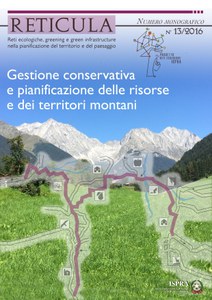Reticula n. 13/2016 - Monograph number
Conservative management and resource planning in mountain areas
Summary
Preface by the Planning Sector of the Department of Nature Protection
The editorial
Seen from above
The future of the country from the point of view of the mountain
by L. Lo Bianco
I. Governance for ecological connectivity in the Alps in the framework of international Conventions and macro-regional strategy
P. Angelini, L. Cetara, M.T. Idone
II. Sustainable Forest Management in the Alpine area
F. Dellagiacoma
III. The Apennines after the earthquake: what development perspectives for local communities?
I. Pierantoni, M. Sargolini
IV. Protection and promotion of the high lands: the role of the Italian Alpine Club
F. Di Donato
V. Between Italy and France, some drops of Europe
R. Pozzani
VI. The agro-pastoral landascapes in the Majella National Park: the landscape evolution and new monitoring techniques
E. Micati, A. Manzi, G. M. Monaco, L. Di Martino, A. Marucci, M. Gambacorta, O. Di Nino
VII. Energy efficiency renovation and architectural redevelopment in the alpine territory. Scenarios from the AlpBC project
M. Berta, A. De Rossi, R. Dini
VIII. Land evaluation of mountain areas on the basis of their natural constraints
P.F. Martalò, F. Mensio, P.G. Terzuolo, E. Raina
IX. Rural Development Programmes role in the change of mountain agricultural landscapes: application of an interpretive model to the Lazio region
M.C. Natalia
X. Dry grassland management in the frame of Natura 2000 Network applied by means of the LIFE+ RI.CO.PR.I.
M. Vinci, V. Buonfiglio, L. Vannicelli Casoni
XI. Renewable energy for the resilience of an alpine community: the hamlet of San Bernolfo, Vinadio (CN)
L. Bisogni, D. Cavedal
XII. Protected areas, land planning and mountains in Developing Countries: an interesting experience in Tanzania
C. Sometti, M. Zortea

